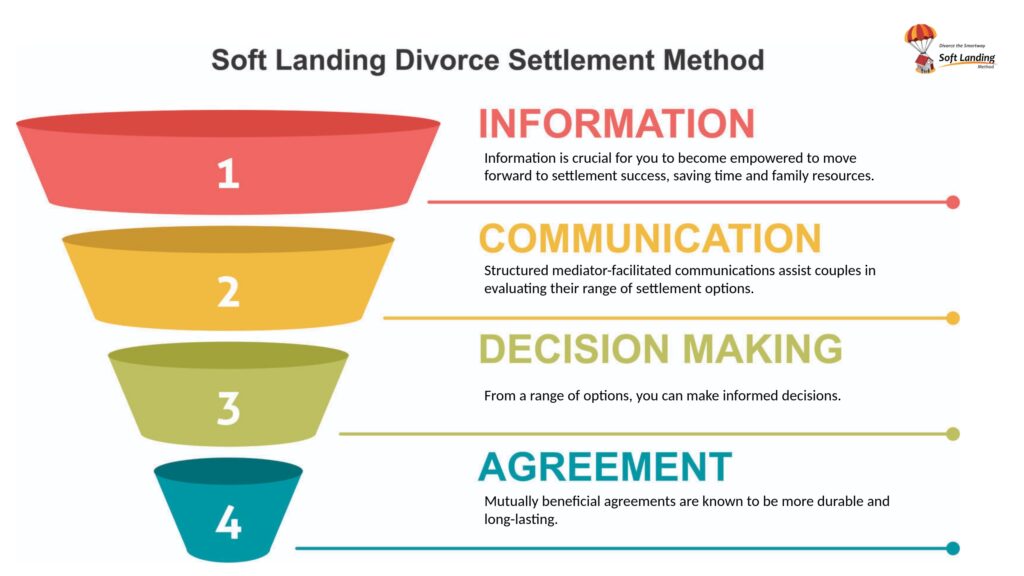One Person’s Legal Separation Agreement Journey



Yes, a mediator can assist in writing a separation agreement. While mediators facilitate the discussion and help draft the terms, the final agreement should be reviewed by a lawyer to ensure it meets legal standards.
A mediator helps by facilitating discussions between the parties, ensuring both sides are heard, and guiding them to mutually agreeable terms. They draft the agreement based on these discussions and ensure clarity and fairness.
While you do not need a lawyer to use a mediator, it is advisable to have a lawyer review the final agreement. This ensures that the document is legally sound and protects your rights.
The benefits include a collaborative process, reduced conflict, cost savings, and a focus on mutual agreement. Mediators can help ensure that both parties feel heard and that the agreement is fair and balanced.
Yes, once the separation agreement is signed by both parties and witnessed, it is legally binding. However, it is recommended to have a lawyer review it to ensure compliance with legal standards.
The process involves initial consultations, facilitated discussions to reach mutual agreements, drafting the terms of the agreement, and reviewing the final document. The parties then sign the agreement, making it legally binding.
Both mediators and lawyers can draft separation agreements. Mediators help facilitate the discussion and agreement, while lawyers ensure the document is legally enforceable and meets all legal requirements.
A separation agreement should include terms related to property division, spousal support, child custody and access, child support, and any other relevant issues. It should be clear, detailed, and mutually agreed upon.
The time it takes can vary depending on the complexity of the issues and the willingness of both parties to reach an agreement. On average, it can take a few sessions over several weeks to finalize a separation agreement.
Yes, mediation is generally cheaper than litigation. Mediation focuses on collaborative resolution, which can reduce costs associated with lengthy legal battles and court fees.
Yes, both parties must agree to use mediation for it to be effective. Mediation is a voluntary process, and both parties need to be willing to participate in good faith to reach a mutual agreement.
Yes, a mediator can facilitate the exchange of financial information between the parties. Full financial disclosure is essential for creating a fair and comprehensive separation agreement.
Mediation offers a more amicable, cost-effective, and quicker resolution compared to litigation. It allows for collaborative decision-making and helps maintain better relationships between the parties involved.
After drafting, the agreement should be reviewed by each party’s lawyer to ensure it is legally sound. Once reviewed, the parties sign the agreement, making it legally binding and enforceable.
Fairness is ensured by facilitating open communication, ensuring both parties’ concerns are addressed, and drafting terms that are mutually agreeable. Having the agreement reviewed by lawyers also helps ensure legal fairness.
Yes, a separation agreement can be contested in court if one party believes it is unfair or if there was a lack of full disclosure. Courts can review and, if necessary, modify the terms to ensure fairness.
Yes, mediators are neutral third parties who facilitate discussions and help both parties reach a fair and balanced agreement. Their role is to ensure that both parties are heard and that the agreement is mutually satisfactory.
In Ontario, a separation agreement does not need to be notarized to be valid or enforceable. Notarization is not a legal requirement for a separation agreement to hold legal weight. However, it can provide additional evidentiary support and may be recommended in certain situations.
Notarization involves having a document signed in the presence of a notary public, who then verifies the identities of the parties and witnesses the signing. The notary public also affixes their official seal or stamp to the document.
While notarization is not mandatory, parties may choose to have their separation agreement notarized for several reasons:
- Evidentiary Support: Notarization creates a strong evidentiary record of the signing and can help establish the agreement’s authenticity and validity in case of future disputes.
- Increased Perceived Legitimacy: Some individuals may view notarization as an additional layer of formality and legitimacy for the agreement. This can provide a sense of assurance and peace of mind.
- International Use: If parties plan to use the separation agreement in another jurisdiction or for purposes such as immigration or international travel, notarization may be required or preferred by the authorities in those jurisdictions.
It’s important to note that notarization does not automatically make an agreement more enforceable or legally binding. The key factors in the enforceability of a separation agreement are voluntary consent, independent legal advice, financial disclosure, and compliance with other legal requirements.
Separation agreements in Ontario are legally binding contracts that establish the rights and obligations of separating or divorcing parties. These agreements provide a framework for dividing assets, determining support payments, and resolving other important matters. Here’s an overview of how separation agreements work in Ontario:
- Negotiation and Discussion: The parties negotiate the terms of the separation agreement, either directly or with the assistance of their respective lawyers or a mediator. They discuss various issues, including division of property, spousal support, child custody, access, and support. Open and honest communication is crucial during this process.
- Financial Disclosure: Both parties must provide complete and honest financial disclosure, including assets, debts, income, and expenses. This ensures that each party clearly understands the financial picture and can make informed decisions.
- Terms and Conditions: The separation agreement outlines the agreed-upon terms and conditions regarding various aspects of the separation. It includes provisions related to asset division, spousal support, child custody, access, and support. The agreement should be clear, specific, and unambiguous to minimize future disputes.
- Legal Advice: Each party is strongly encouraged to seek independent legal advice from their own lawyer before signing the separation agreement. Lawyers help ensure that the agreement protects their client’s rights and interests and complies with the applicable laws in Ontario.
- Execution and Witnessing: The separation agreement is signed by both parties, showing their voluntary consent to the terms outlined. It is advisable to have the agreement witnessed by an impartial third party and dated to provide additional evidentiary support.
- Legal Effect and Enforcement: Once signed, a separation agreement in Ontario becomes legally binding and enforceable. It is considered a contract between the parties. If either party cannot comply with the agreed-upon terms, the other party can seek enforcement through the court system.
- Registration and Incorporation: While not mandatory, parties may choose to register the separation agreement with the court or incorporate it into a court order. This provides additional legal weight and facilitates enforcement if necessary.
Separation agreements offer flexibility, allowing parties to tailor their own terms according to their unique circumstances. However, it is important to ensure that the agreement meets the legal requirements, protects the rights of both parties and complies with the laws of Ontario. Consulting with a family law lawyer is highly recommended to navigate the process and ensure the agreement’s validity and enforceability.
Several factors might void or invalidate a separation agreement in Ontario. It is important to be aware of these circumstances to ensure the agreement’s enforceability. While consulting with a family law lawyer is advisable for specific legal advice, here are some common reasons that may void a separation agreement:
- Lack of Voluntary Consent: If either party can show that they entered the agreement under duress, coercion, fraud, or undue influence, it may be deemed invalid. Voluntary consent is a fundamental requirement for a separation agreement to be enforceable.
- Lack of Independent Legal Advice: If one or both parties did not receive independent legal advice before signing the agreement, it may be challenged on the grounds of inadequate understanding or not being fully informed about their rights and obligations. Having independent legal advice helps ensure that both parties make informed decisions.
- Lack of Financial Disclosure: If one party can prove that the other party failed to provide complete and honest financial disclosure during the negotiation process, it may render the agreement void. Full financial disclosure is necessary to ensure transparency and fairness in asset division and support obligations.
- Illegality or Public Policy Violation: If the separation agreement includes provisions that violate Ontario’s laws or public policy, those specific provisions may be deemed unenforceable or void. For example, an agreement that waives a child’s right to financial support may be considered against public policy and unenforceable.
- Mistake, Misrepresentation, or Fraud: If a party can show that the separation agreement was based on a mistake, misrepresentation of facts, or fraud, it may be challenged and potentially invalidated.
- Material Change in Circumstances: While not directly voiding the agreement, a material change in circumstances after the agreement’s execution may provide grounds to seek a modification or variation of the agreement. A significant change in financial circumstances, child-related matters, or other relevant factors may warrant a review and potential adjustment of the agreement.
It is important to consult with a family law lawyer to fully understand the specific legal grounds that may void a separation agreement in Ontario. They can provide personalized guidance based on the details of your situation and help protect your rights throughout the process.
Yes, a separation agreement in Ontario can be legally binding if certain they meet certain requirements. To ensure that a separation agreement is legally enforceable, it is important to consider the following factors:
Voluntary Consent: Both parties must enter the agreement voluntarily, without coercion or undue influence. It is crucial that each party fully understands the terms and implications of the agreement.
Independent Legal Advice: It is recommended that each party seeks independent legal advice from their own lawyer before signing the separation agreement. This ensures that both parties are aware of their rights, obligations, and the consequences of the agreement.
Full Financial Disclosure: Each party must provide complete and honest disclosure of their financial situation, including assets, debts, income, and expenses. Transparency in financial disclosure is vital to ensure fairness in the division of assets and determination of support obligations.
Consideration of Children’s Best Interests: If the separation agreement includes provisions related to child custody, access, and support, the best interests of the children should be taken into account. The terms should be reasonable and provide for the well-being and welfare of the children involved.
Certainty and Clarity: The separation agreement should be clear and unambiguous and address all relevant issues, such as property division, spousal support, child custody, and access. The terms should be specific, leaving no room for misinterpretation or confusion.
Legal Formalities: While not strictly required, it is advisable to have the separation agreement witnessed and dated. Notarizing the agreement can provide additional evidentiary support if ever disputed it in the future.
Once these requirements are met and the separation agreement is properly executed, it becomes a legally binding contract between the parties. It is essential to consult with a family law lawyer to ensure that the agreement meets the legal standards and adequately protects your rights and interests.
Yes, if you signed a prenuptial agreement before your marriage, this may specify how assets will be divided upon the breakdown of the marriage. Also, if you are not married but have signed a Cohabitation agreement, this could well lay out how assets and debts should be divided if the relationship breaks down.
This is obviously a very important step, as the terms in your separation agreement will affect your future and that of your children. It’s a binding contract that is legally enforceable, so you must honour its terms. Often, it will be used as the basis for your divorce. So be sure you are content with it before you sign it. Ideally get a legal representative to create it, or at least review it before you sign it because everything needs to be carefully considered.
A separation agreement in Ontario is a legally binding document that outlines the terms and conditions agreed upon by separating or divorcing parties. While the specific requirements may vary depending on the circumstances, there are key elements that should typically be included in a separation agreement:
Identification of Parties: Clearly state the full names and contact information of both parties involved in the agreement.
Effective Date: Specify the date from which the agreement becomes effective and enforceable.
Living Arrangements: Address the living arrangements for both parties, such as who will continue residing in the matrimonial home or if separate residences will be established.
Division of Assets and Debts: Detail how assets, including property, vehicles, bank accounts, investments, and debts, will be divided between the parties. Specify if any assets are to be sold, and how the proceeds will be distributed.
Child Custody and Access: Outline the arrangements for child custody, including decision-making responsibilities and the schedule for the children’s time with each parent. Address how major decisions regarding the children’s upbringing, education, healthcare, and religion will be made.
Child Support: Specify the amount and frequency of child support payments and any special expenses that will be shared between the parties, such as childcare or extracurricular activities.
Spousal Support: If applicable, define the terms of spousal support, including the amount, duration, and any conditions for termination or modification.
Health Insurance and Benefits: Address the provision of health insurance coverage for the children and determine how other benefits, such as dental or vision coverage, will be managed.
Dispute Resolution: Include provisions for resolving future disputes or disagreements, such as through mediation or arbitration, to avoid resorting to court litigation.
Full and Final Release: Include a clause showing that the agreement represents a full and final settlement of all claims and that both parties fully release each other from any further obligations arising from the relationship.
Independent Legal Advice: Acknowledge that each party has obtained independent legal advice before signing the agreement.
It is crucial to consult with a family law lawyer to ensure that your separation agreement meets your specific needs and complies with the relevant laws in Ontario. A lawyer can provide guidance, review the agreement, and help ensure that your rights and interests are protected throughout the process.
If your spouse refuses to sign a separation agreement, you should consider entering divorce mediation or secure the services of separate lawyers in order to reach a separation agreement that works for you both.
Yes, if the courts think your separation agreement is not in the best interests of your children, if one spouse hasn’t disclosed certain assets and liabilities, or if the terms of the separation are unfair, then the separation agreement will not be legally enforceable.
Separation agreements are serious documents for use in court if necessary, so any terms that aren’t clear or are blatantly unreasonable will not be accepted. However, judges won’t change the terms of property division or spousal support that are proposed in your separation agreement, even if they don’t agree with them. So you need to have total confidence in your separation agreement before you sign it. You may want to checkout my Step-by-Step Guide to Preparing your own separation agreement HERE
Yes, it is possible to write your own separation agreement in Ontario, but it is highly recommended to seek legal advice to ensure its accuracy and effectiveness. While you have the freedom to create your own separation agreement, it is essential to understand the legal implications and requirements involved.
Here are some considerations when drafting your own separation agreement in Ontario:
Legal Knowledge: Familiarize yourself with Ontario’s family laws and regulations that govern separation and divorce. Understanding the legal framework will help ensure that your agreement addresses all necessary aspects and complies with the relevant legal provisions.
Clarity and Detail: A well-drafted separation agreement should be clear and comprehensive and address various key issues, including child custody and access, child support, spousal support, division of assets and debts, and any other relevant matters in your specific situation. Providing specific details and considering potential future scenarios can help minimize conflicts or ambiguities.
Independent Legal Advice: While you may draft the agreement on your own, it is strongly recommended that each party seeks independent legal advice. This ensures both parties understand their rights, obligations, and the agreement’s implications. Lawyers can review the agreement, provide guidance, and ensure it is fair and legally sound.
Financial Considerations: Consider financial matters such as the division of property, assets, debts, and any required financial support. Consultation with financial professionals, such as accountants or financial advisors, can provide valuable insights into the financial aspects of the agreement.
Formalization and Legal Requirements: To make the separation agreement legally binding, it is advisable to have it signed and witnessed by both parties. Although not mandatory, having the agreement notarized can also be beneficial. I recommend consulting with a lawyer to determine if it should register the agreement with the court or if it needs to be incorporated into a court order.
While you can draft your own separation agreement, it is important to approach the task with caution and seek legal guidance to ensure the document accurately reflects your intentions, protects your rights, and complies with the applicable laws in Ontario.
Any couples planning to separate will benefit from having a separation agreement as it will address key issues associated with the separation, particularly child custody issues, and financial ones, without having to go to court, thereby avoiding costly litigation. Such an agreement gives you control over who gets what, and often the courts will incorporate the terms of your separation agreement into the divorce judgement.
A separation agreement (also called a Marital Separation Agreement) is a legally binding contract that two people who are married create to formalize the terms of their separation. As such, it is governed by the law of contract, so failure by either party to honour its terms can result in claims of breach of contract.
The separation agreement lays out each partner’s rights regarding various issues, most notably: property division, child access and custody rights, child and spousal support, and other financial matters. Although a separation agreement isn’t required by law to be in writing, it’s recommended to document it in writing as any separation agreements made verbally are hard to prove in court. Separation agreements will be respected by the courts as long as they are deemed fair, reasonable and properly executed.
You don’t have to be living in different homes to be classified as being separated. You can be classed as ‘living separately and apart’. It’s all about whether or not you are living separate lives. Yes, different addresses will prove it, certainly as far as the courts are concerned. But in some separations, living at different locations isn’t financially viable, or indeed possible due to childcare needs, so you can live in the same house and still be classed as being separated. It falls on the couple to prove to the courts that they are living separate lives even though they are inhabiting the same space. It’s a complex process that usually requires legal expertise to prove. Usually, the following factors will be taken into account:
- Lack of communication between spouses
- Taking separate meals
- Not doing things together
- No sexual relations
- Division of assets and finances
- Division of household responsibilities
Any reconciliation won’t re-start the one-year‘ countdown clock’ until you are back together for a total of 90 days. The aim of the one year period is to give couples the opportunity to work on their marriage and give their relationship another try, without delaying a divorce if they don’t succeed. Should you stay together for more than 90 days, then your one year period will start over again.
In Ontario, if you want to file for divorce, you need to complete a full, one year separation period, unless you file your divorce on the grounds of cruelty or adultery. Of course, you can begin applying to get divorced on the day you and your partner separate, but no Canadian court will grant you a divorce until a full year has passed. The three grounds that are acceptable for getting divorced in Ontario are outlined in the Divorce Act, which we explain on our Divorce page.
There’s no time limit. A divorce doesn’t automatically kick-in just because you and your spouse have been living separate lives for, say, 5 years. You can remain separated for as long as you like without needing to get divorced. The only reason one or both of you might seek a divorce is if you want to marry someone else.
Do I need to file for a legal separation in Ontario?
External links that may interest you
- Separation and annulment | Alberta.ca – A separation agreement is a contract between parties who are separating or divorcing, covering child custody and support.
- Separation – Guide on making a separation agreement legally binding, covering essential issues.
- Making an agreement after you separate | Family Law in BC – Tips on writing a separation agreement with or without professional help.
- Write your own separation agreement – Family Law in BC – Guide to writing a legally binding separation agreement during divorce or separation.
- Know Your Rights for Separation and Separation Agreements – Overview of what a separation agreement is and its importance.
- Separation Agreements – Emphasizes the need for independent legal advice for legally binding agreements.
- Divorce and Separation – Information on separating or divorcing and related family law complexities.
- Legal separation (separation from bed and board) – Explains how legal separation differs from divorce, maintaining marital bonds.
- Separation of Legal Spouses and Common-law Partners – Assistance with completing forms for separation.
- When Couples Separate – Clarifies that legal separation doesn’t require a court order but requires resolving family law matters.
- What Is a Legal Separation Agreement? – Explains the requirement of living apart for at least a year before divorce in Saskatchewan.
- Separation agreement certificates – Explains how separation agreements can arrange custody, access, and child support.
- Make a separation agreement – Outlines creating a written contract to manage separation issues.
- Separation – Covers Manitoba law on separation matters for spouses and common-law partners.
- Separation agreements – FREE Legal Information – Highlights that writing a separation agreement is voluntary but beneficial for establishing legal separation.
Ken Maynard CDFA, Acc.FM
I assist intelligent and successful couples in crafting rapid, custom separation agreements that pave the way for a smooth transition towards a secure future. This efficient process is achieved in about four meetings, effectively sidestepping the excessive conflicts, confusion, and costs commonly linked to legal proceedings. Clients have the flexibility to collaborate with me either via video conference or in-person through a DTSW associate at any of our six Greater Toronto mediation centers, located in Aurora, Barrie, North York, Vaughan, Mississauga, and Scarborough.
Have a few questions - Tap here to Schedule a Get Acquainted Call



 Full
Full 
















































